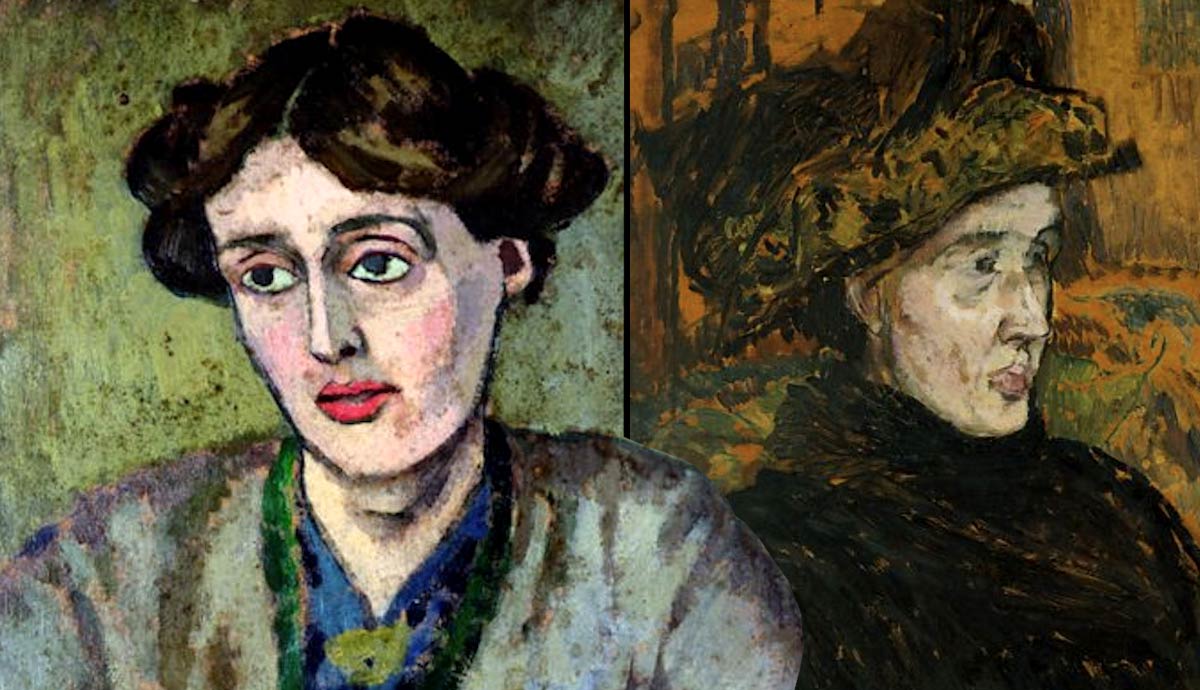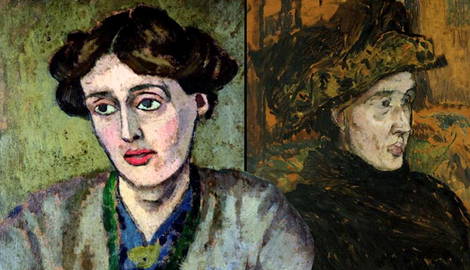
While most know Virginia Woolf as the author of great novels like Mrs. Dalloway and To the Lighthouse, she was also a member of the famed Bloomsbury group and a highly influential figure in the art world. As part of her expansive body of work, Woolf wrote essays on art criticism that have since been published as a book titled Oh, To Be a Painter. Woolf’s novels had a great impact on modernism and, in turn, the modernist art movement.
9. Virginia Woolf by Vanessa Bell (1912)

Virginia Woolf inspired fellow Bloomsbury Group members through her work and personal relationships, including a long-lasting love affair with Vita Sackville-West. Her letters and communications with Sackville-West have inspired countless literary works, artworks, cinema, and plays in the LGBTQ+ genre.
One of the first people Virginia Woolf (1882-1941) inspired artistically was her older sister Vanessa Bell (1879-1961). Bell painted a portrait of her younger sister titled Virginia Woolf in 1912, where Woolf is depicted knitting in an orange armchair. This painting shows an intimate relationship between the two sisters, though Bell’s painting style leaves the fine details of the scene out of focus. Virginia and Vanessa were involved in many joint creative pursuits as members of the Bloomsbury Group (or Bloomsbury Set), a group of writers, artists, and creatives started by Vanessa in 1912.
8. Virginia Woolf by Duncan Grant (1911)

Duncan Grant (1885-1978) was a British painter, member of the Bloomsbury Group, and lifelong friend of Virginia’s. Though Grant typically had relationships with men, he was bisexual and had a relationship with Woolf’s sister, Vanessa Bell. He was also inspired by Virginia Woolf and created a portrait of her in 1911 titled Virginia Woolf. This portrait is a great example of the reverence with which Woolf’s friends and relatives treated her; her inner circle depicted her as an important subject. Here, Woolf’s large hat, dark clothing, and almost stoic expression paint a picture of the artist’s personal relationship with her.
7. Portrait of Virginia Woolf by Roger Fry (1917)

Roger Fry (1866-1934) was yet another member of the Bloomsbury Group who painted a portrait of Virginia Woolf. Fry was a painter and art critic from London with a reputation for studying French painting and the Old Masters. Portrait of Virginia Woolf (1917) is a stunning post-impressionist work that provides yet another look into Woolf’s personal relationships and friendships. Woolf and Fry were great friends and after his death, Woolf wrote a biography of Fry, stating in it that Roger Fry remained to the last a man with a limitless appetite for intellectual curiosity. Fry’s portrait of Woolf, who was about 35 years old when it was painted, has much more defined lines and features than Bell’s or Grant’s and remains a unique picture of the woman she was.
6. A Sisterly Duo: Virginia and Vanessa’s Collaborations

One example of the joint creative work Virginia and Vanessa created together is their collaboration through the Hogarth Press. The Hogarth Press was a British publishing house founded in 1917 by Virginia Woolf and her husband, Leonard. The Woolfs started hand-printing books in the interwar period, and Virginia recruited her sister to create art for the covers and inner pages of her publications. On the opening page of Kew Gardens (1927), a short story by Virginia Woolf, Vanessa Bell created several line-drawn illustrations. These drawings beautifully reflect the descriptive language Woolf uses in the text but leave the colors Woolf has so beautifully described to the reader’s imagination.
5. Duncan Grant and Vanessa Bell’s Famous Women Dinner Service (1932)

The Famous Women Dinner Service (1932) is an example of one of the quirkier artworks with inspiration from Virginia Woolf. Created by Vanessa Bell and Duncan Grant, Famous Women Dinner Service was a set of fifty dinner plates commissioned by Kenneth Clark, a British art historian and museum director. Each plate in the collection contained a drawing of a famous woman throughout history, from Mary Queen of Scots to Greta Garbo to Virginia Woolf. This collection is considered a precursor to Judy Chicago’s The Dinner Party (1974-79), a feminist installation artwork. Vanessa knew her sister was a great and talented novelist who would be a long-lasting historical figure, reflected by her inclusion of Virginia in a collection of the most iconic women.
4. Virginia Woolf by Man Ray (1934)

Man Ray (1890-1976) also took inspiration from Virginia Woolf in late November of 1934, when she visited one of his exhibitions in London and agreed to sit for a photograph. Man Ray was an American visual artist with many contributions to Dada and Surrealism. His photograph of Virginia, entitled Virginia Woolf (1934) was described by her husband Leonard Woolf as the best photo of her ever taken. This photograph of Virginia Woolf is certainly striking, and it stands out from other depictions of her in that it does not rely so heavily on her artistic prowess or authority as a subject. Instead, a more human side of Virginia is shown, with a small smile and lipstick on her lips.
3. Portrait of Virginia Woolf by Gisèle Freund (1939)

Portrait of Virginia Woolf was taken in 1939 by Gisèle Freund (1908-2000), a German French photographer. Virginia is seen here with a cigarette holder, a book, and an intricate abstract mural in the background. In this photograph, Virginia was fifty-seven years old and she only lived for two more years. She had been communicating with Vita Sackville-West (1892-1962), an English author and journalist, for seventeen years at that point. Woolf’s relationship with Sackville-West was deeply affectionate, and both women exchanged love letters back and forth for much of their lives after meeting at a London dinner party. Their love letters have been collected and published in a book called Love Letters: Vita and Virginia, and there have been film and play adaptations of their story.
2. Virginia Woolf by Stephen Tomlin (1953)

Virginia Woolf (1953) is a lead sculpture by Stephen Tomlin (1901-1937), a British artist who was also associated with the Bloomsbury Group. As a bisexual man, Tomlin had relationships with many people in Woolf’s inner circle, including Henrietta Bingham, Dora Carrington, Julia Strachey, Lytton Strachey, and Duncan Grant. He was generally known as a heartbreaker within the Bloomsbury circles, but many were fond of him nonetheless. He sculpted this bust of Virginia Woolf in 1931 under her reluctant agreement. Though Woolf spent her days with friends and admirers, she hated sitting for the sculpture and being looked at by the artist. Though Woolf felt uncomfortable during the artistic process, the resulting lead bust captures a good picture of her. Her expression is solemn, but the sculpture also shows her to have a stately nature, perhaps a reflection of the admiration of her peers and contemporaries.
1. References to Virginia Woolf Today: Carlos by France-Lise McGurn (2018)

As a great novelist and modernist icon, Virginia Woolf will continue to have an impact on art and literature for years to come. One more modern example of Woolf’s impact on the art world is France-Lise McGurn’s Your Daughter’s Daughter (or Carlos) (2018). The title of this piece is a direct allusion to the Virginia Woolf quote positing that we think back through our mothers.
Even in small ways, Virginia Woolf’s ideas and writings have had a major impact on the education and development of many artists, starting with the Bloomsbury Set and extending into the future. Woolf’s impact on the art world and the way we tell stories is apparent, striking, and inspiring.










